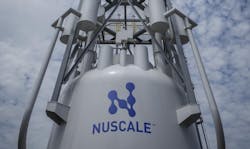Small Nuclear designer NuScale Power joins Shell in evaluating future of Green Hydrogen
Small Modular Reactors (SMR) firm NuScale Power is working with Shell Global Solutions to develop and evaluate a concept for an economically-optimized Integrated Energy System (IES) to produce hydrogen using electricity and heat from a NuScale VOYGR SMR power plant.
The SMR technology can balance and stabilize renewable energy-powered grids through hydrogen production. The energy markets will use hydrogen as the end-product or as a stored energy source for processing via a Reversible Solid Oxide Fuel Cell (RSOFC) for electricity generation.
The firms will modify a NuScale control room simulator to evaluate the dynamics of the IES and include models for the Solid Oxide Electrolysis Cell (SOEC) system for hydrogen production. The research will consider the number of NuScale Power Modules that will be required in the SOEC hydrogen production and the quantity of hydrogen stored for subsequent electricity production.
The firms will also evaluate the local economic factors from the UAMPS Carbon Free Power Project, like the impact in the Western Energy Imbalance Market, resource adequacy programs, and other local market factors.
See more EnergyTech stories on NuScale and other SMR Nuclear technologies
Read more on Hydrogen and Fuel Cell Technologies
“We are pleased to join this collaboration, which is in line with our efforts to explore technologies that have the potential to enable decarbonization and support the energy transition,” said Dirk Smit, Vice President of Research Strategy at Shell.
Energy transition companies are eyeing hyrogen as a power generation and transportation resource because it does not emit CO2 when combusted. H2, however, is not easily gathered in nature so must be generated from either steam reforming of methane gas, which is carbon intensive, or by electrolysis which uses electricity to separate the atom from water.
To be considered truly green, hydrogen must be created by electrolyzers powered by carbon-free resources such as solar, wind, hydropower or nuclear.
